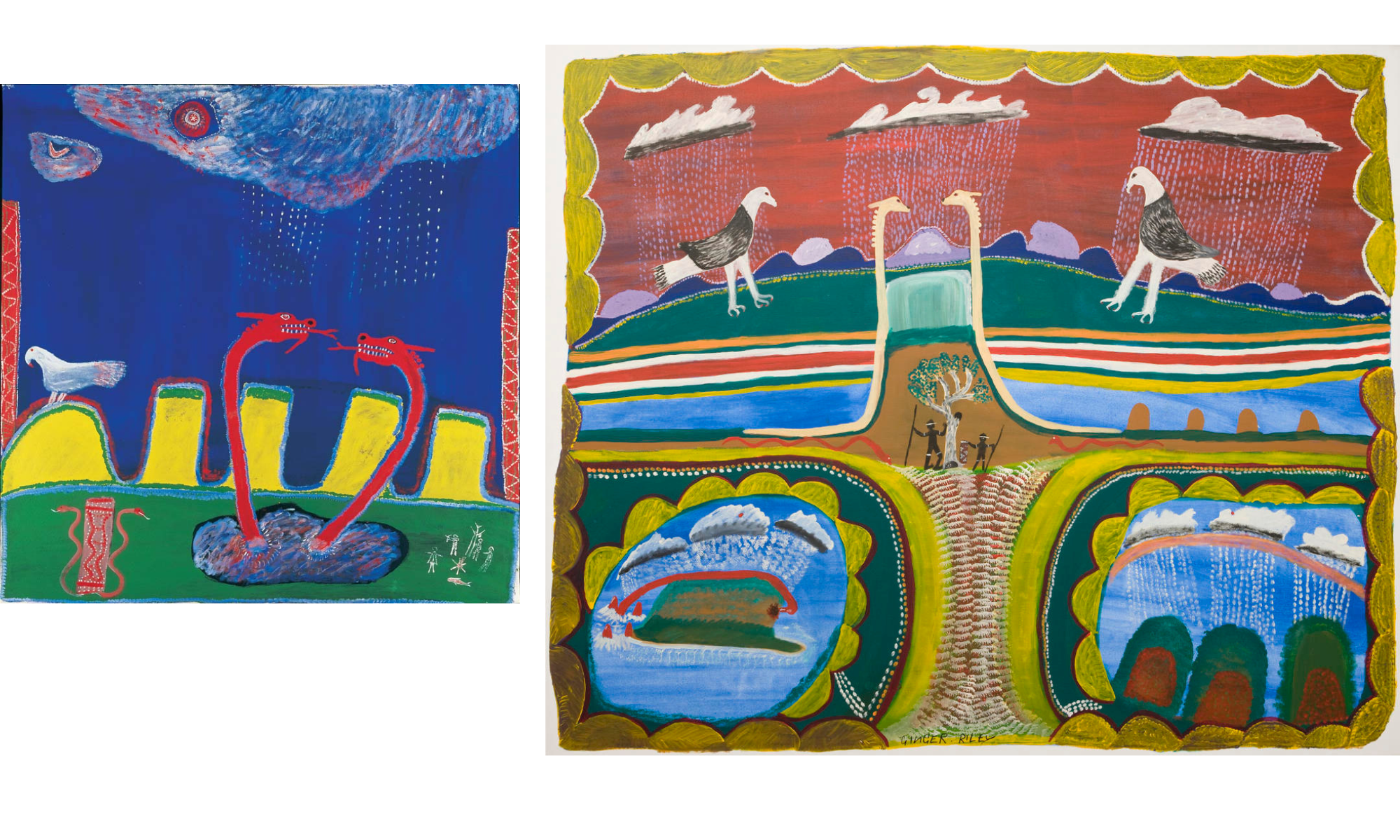Ginger Riley Munduwalawala is a towering figure in the world of Indigenous Australian art
Born in 1936 near the Limmen Bight River in the Gulf of Carpentaria, his work, celebrated for its vibrant colors and bold depictions of his mother's country, has left an indelible mark on the contemporary art scene.
Riley's artistic journey was deeply influenced by his Marra heritage and the rich stories of his homeland. His paintings are a testament to the connection between the land, its people, and their ancestral stories. He is renowned for his distinctive use of color, with brilliant blues, greens, and reds that bring to life the landscapes, animals, and spirit beings of his country.

GINGER RILEY MUNDUWALAWALA L Garimala (The Two Snakes) 1988 R Ceremony time in Limmen Bight Country during the wet season, 1996
His art is an interpretation of a sequence of events centered around his mother's country, the area surrounding the Limmen Bight and the Limmen Bight River in the Northern Territory, Australia. This region, characterised by the geographical formation known as the Four Archers, encompasses the Limmen Bight River and the Maria and Beatrice Islands at the river's mouth. In his paintings, Riley often depicts elements of his creation story, with his mother represented as the cloud and the sun, and imagery of heavy rain-filled clouds, fine rain, and bright sunlight.
The artist narrates the journey of Garimala, the creator snakes, who traveled from Arnhem Land to a waterhole they created near the Four Archers. These snakes then journeyed to Ngamiyukandji, a rock in the Limmen Bight River, where they transformed into the Rainbow Serpent Bulukbun. In another manifestation, Bulukbun becomes a fire-breathing serpent-dragon, surfacing among a group of small pyramid-shaped islands and displaying aggression towards those who displeased him during initiation ceremonies on Beatrice Island.
A central figure in Riley's work is the totemic white-breasted sea eagle, Ngak Ngak, often depicted as a guardian of the country. Ngak Ngak is associated with Beatrice Island, formed when the eagle flew over it, and is frequently shown looking at its own image or a message stick. This symbol of vigilance and protection is a recurring motif in Riley's art, embodying the spiritual connection to his mother's country and the broader narratives of his cultural heritage.
Riley's use of bold, flat colors and the absence of traditional dotting techniques set his work apart from other Indigenous artists, making it instantly recognisable. His contribution to Aboriginal art extends beyond his individual creations. He was a trailblazer in bridging the gap between Indigenous and non-Indigenous art worlds, paving the way for future generations of Indigenous artists to gain recognition and respect for their work. His paintings have been exhibited in major galleries and collections both in Australia and internationally, showcasing the richness and diversity of Indigenous Australian art.
Throughout his career, Ginger Riley Munduwalawala received numerous accolades for his contributions to the arts, including being the first Indigenous artist to have a solo exhibition at the National Gallery of Victoria. His legacy is one of artistic innovation, cultural pride, and a deep reverence for the land and its stories.
Reflecting on Ginger Riley's life and work, one is struck by the power of his art to transcend cultural boundaries and speak to universal themes of connection to place and the natural world. His paintings are not just visually stunning; they are a celebration of the enduring spirit of the Marra people and their land. Through his vibrant canvases, Ginger Riley Munduwalawala continues to inspire and captivate, ensuring that his Mother Country and its stories will be remembered and cherished for generations to come.







